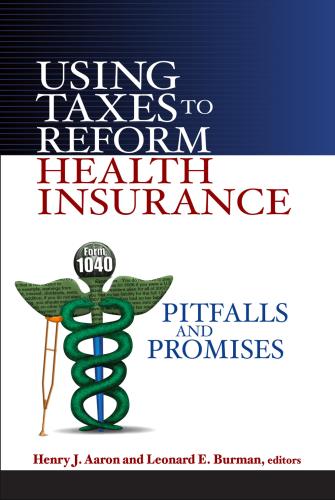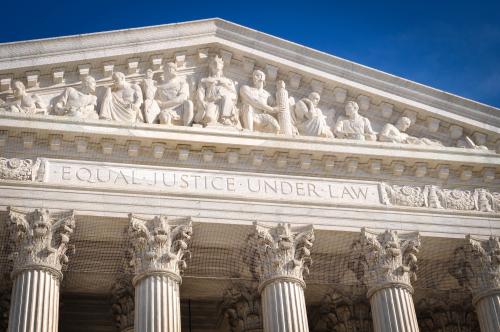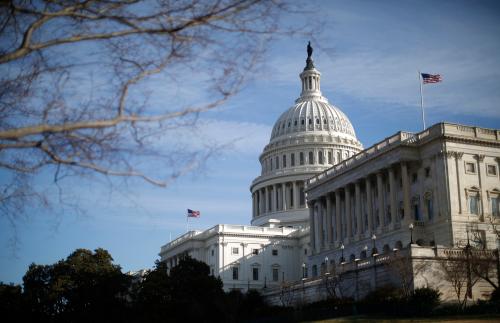This analysis is part of the USC-Brookings Schaeffer Initiative for Health Policy, which is a partnership between Economic Studies at Brookings and the University of Southern California Schaeffer Center for Health Policy & Economics. The Initiative aims to inform the national health care debate with rigorous, evidence-based analysis leading to practical recommendations using the collaborative strengths of USC and Brookings.
Since Bill Barr became Attorney General in February of this year, the Department of Justice’s behavior in Texas v. U.S. – the current lawsuit challenging the ACA – has been unpredictable and inconsistent. Most notably, the Department came under fire in March when they reversed course and began arguing that the entire ACA should be struck down, a position that received criticism even from prominent conservative legal scholars.
In a move that’s received far less attention, this summer DOJ made clear a new position on another aspect of the case. Specifically, on July 3 DOJ filed a letter arguing for the first time that a victory in this case would invalidate the ACA “in the plaintiff states” – but only in the plaintiff states. That is, DOJ is asking the Fifth Circuit to strike down provisions of the ACA in Texas and 17 other states, but has newly taken the position the Fifth Circuit should not strike down the ACA in the rest of the country. It’s not at all clear that DOJ has thought through the implications of this argument.
This piece describes the claim DOJ has made, attempts to unpack some of the complicated policy implications, and then considers the relevant legal issues.
DOJ’s Argument
A full explanation of the many legal issues at play in Texas v. U.S. is beyond the scope of this piece. For our purposes, note that DOJ is currently arguing three things:
- The individual mandate cannot be severed from the rest of the ACA. If the mandate is unconstitutional, then Congress would not have wanted anything else to remain in law.
- The Fifth Circuit must limit its relief to provisions that injure the individual plaintiffs in the case. Most specifically, the court should not strike down provisions in the ACA that DOJ relies on to prosecute Medicare and Medicaid fraud; those provisions are indeed inseverable, but they cannot be affected by this case because they do not affect the individual plaintiffs (i.e. the two individual people who have joined the states arguing against the ACA).
- A Fifth Circuit judgment invalidating the ACA should only apply in the 18 plaintiff states.
These last two claims are jurisdictional: DOJ is not arguing that these limits apply indefinitely, only that they would apply to this particular decision, and other parties in other suits could seek to have ACA provisions struck down in other states. That is, while the DOJ continues to argue that the entire ACA is invalid in all states, its latest legal position, if accepted, would temporarily limit invalidation to only some states and to only some provisions of the ACA. (Wondering which states are plaintiffs in the case? Find out where your state stands here.)
The next section considers some of the key policy implications if DOJ’s position were to prevail.
The Policy Issues
The ACA is a piece of transformative legislation that affects nearly every aspect of our health care system, and it can’t simply be turned on and off at a state border. To consider some aspects of the law:
Medicaid and the Individual Market
First, note that for some provisions of the law there are relevant dividing lines between states. The individual insurance market and Medicaid are state-specific, and there are differences between states in Medicaid eligibility and individual market benefit design and rating rules. Still, the scope of the state variation that DOJ is contemplating here is large. DOJ seems to be implying that individual market regulations (like prohibiting discrimination based on pre-existing conditions and requiring coverage of essential health benefits) would apply in some states and not others, and the ACA’s billions of dollars in individual market financial assistance would be limited to residents of non-plaintiff states. Similarly, DOJ’s view would presumably mean that the ACA’s enhanced matching funds for Medicaid expansion would be available only in non-plaintiff states.
Further, while there are some conceptual diving lines, note that even for portions of the ACA affecting Medicaid or the individual market, significant complications would arise. As just one narrow example: The ACA increased the minimum rebate that drug manufacturers must provide to Medicaid. Separately, a longstanding Medicaid policy requires manufacturers to provide their “best price” to all state Medicaid programs if that price is lower than the statutory minimum rebate. It’s not clear if the larger rebate in states where the ACA remains in effect would factor into the best price calculation, such that plaintiff states would still receive the benefit of the ACA policy.
Employer Health Benefits
Of course, the ACA’s impacts are not limited to Medicaid and the individual market. The ACA includes important reforms that affect employer provided insurance, like prohibiting annual and lifetime limits, capping annual out of pocket expenses, requiring coverage of preventive services, and allowing young adults to stay on their parents’ plan until age 26. These policies were integrated into the Employee Retirement and Income Security Act (ERISA), the comprehensive federal scheme regulating employer-provided health benefits.
As scholars at Georgetown’s Center on Health Insurance Reforms have articulated, a fundamental principle underlying ERISA is that there should be no state-to-state variation in the law governing employer’s health benefits. But DOJ’s position in this case could require national employers to offer different benefits to employees based on the employee’s location. Or, in the alternative, if DOJ’s position were interpreted to apply based on the state in which the employer is headquartered, residents of a state could have different consumer protections based on where their employer was located. Either option would frustrate the basic goals of ERISA and pose significant complications for employers and employees alike.
Revenue Provisions
The ACA provides financial assistance to help millions of low- and middle-income people afford health insurance, and it paid for those programs, in part, by increasing taxes on certain health care companies and on high income people. For example, the law:
- Increased Medicare’s payroll tax for those earning more than $200,000 per year.
- Imposed a Medicare tax on capital gains and other investment income for high earners.
- Imposed an excise tax on branded prescription drugs.
- Imposed excise taxes on insurance companies and medical device companies, though those provisions are not in effect for 2019.
- Limited the tax deduction for insurance company CEO compensation over $500,000.
- Required Blue Cross Blue Shield insurers to forego certain tax benefits if they did not spend a certain fraction of premium revenue on medical costs.
Is DOJ contemplating that these tax provisions would apply in some states but not others? For the provisions that affect individual taxpayers, it would be inconsistent with our general nationwide administration of the federal tax code for high income individuals in California to pay a higher payroll tax than those in Texas. Such an outcome would pose novel questions about equity and fairness in our tax code that go to the heart of what an individual income tax is supposed to represent. In addition, it would pose a significant administrative burden on the IRS to account for different rules in different states and for individuals who moved mid-year. And of course, it’s not at all clear the IRS would be prepared to enforce these distinctions.
Nationwide variation in the implementation of the excise tax provisions could lead to even stranger results. For example, the branded prescription drug excise tax is structured as a “distributed fee”: the IRS is directed to collect $2.8 billion, distributed pro rata across all sellers of covered drugs. If the ACA were in effect in some states but not others, it is unclear if IRS would collect the full amount from the manufacturers in non-plaintiff states, or some reduced amount that takes into account the amounts that otherwise would be owed in plaintiff states.
Medicare
The ACA made many changes to the Medicare program, including expanding benefits (e.g. closing the prescription drug “donut hole” and adding new preventive services), reducing the rates paid to many providers and private insurers participating in Medicare (e.g. changing the formula used to update hospital payments over time), changing the structure of provider payment (e.g. lowering payments to hospitals with high readmission rates and creating opportunities to participate in alternative payment models like Accountable Care Organizations), and empowering CMS to test new Medicare payment models under the auspices of the Center for Medicare and Medicaid Innovation. These policies are today incorporated into Medicare’s fee schedules and payment policies, which, of course, operate on a nationwide basis.
Does DOJ’s position imply that CMS would need to run separate fee schedules for non-plaintiff and plaintiff states? Medicare prescription drug plans may need to be redesigned to reimpose the donut hole and offer less generous benefits in plaintiff states. And the implications for doctors and health systems participating in some Innovation Center payment models are murky – for example, providers in plaintiff states might no longer be eligible for bonus payments they had previously been promised and may have invested significant resources in seeking. Multistate hospital systems might face different Medicare reimbursement systems in different states. Further, it’s unclear what rules would apply if the health system was in a non-plaintiff state but treated a beneficiary from a plaintiff state, or vice versa. This kind of state variation could be destabilizing for communities’ investment in alternative and value-based payment models.
Biosimilar Drugs
The ACA also authorizes the FDA to approve “biosimilar” drugs. Biosimilars are non-brand versions of biologic drugs; like generic drugs, they can be far cheaper than brand alternatives, but prior to enactment of the ACA, the FDA had no pathway to approve their sale in the U.S.
But, of course, the FDA approves drugs on a nationwide basis. It’s not at all clear what it would mean for the FDA to have the authority to approve biosimilar drugs “in” some states but not others. Would FDA be able to approve biosimilars only when made by manufacturers in non-plaintiff states? Would newly approved biosimilars be restricted to sales in non-plaintiff states? Would already-approved biosimilars be pulled from the market in plaintiff states?
The Indian Health Service
The ACA reauthorized the Indian Health Care Improvement Act and modernized policies governing the Indian Health Service, which delivers health care services to the Indian community. There is a tremendous thicket of law around the extent to which Indian reservations are considered “part” of a state for specific purposes in federal law, and the issue goes to the heart of complicated questions about tribal sovereignty. The implications of DOJ’s position for tribal health care services are uncertain and unresolved.
Future Litigation
Quite aside from the complexity of applying state variation with respect to particular ACA policies, an order along the lines DOJ suggests could also create gridlock for the entire health care system – even when it was clear how the decision in Texas v. U.S. was to be applied. Recall that DOJ’s position that the ACA should be struck down in some states but not others is jurisdictional: they claim that as a matter of law all provisions should be struck down everywhere, but no one in this case has standing to strike down ACA provisions in a non-plaintiff state. Presumably, then, other plaintiffs in other litigation could broaden the impact by making the same arguments that Texas and the other plaintiffs make here, provided they had standing do so.
In that environment, anyone negatively affected by any provision in the ACA in a context where the ACA was still in force might sue, and each case might present novel question about the plaintiff’s standing. Is DOJ really envisioning that anytime any health care market actor believes they would be better off if a specific ACA provision was not in effect, that there should be new litigation with uncertain results? Medicare pays more than $700 billion in health care claims every year; after establishing two separate fee schedules ought we then separately litigate every claim in non-plaintiff states? If the ACA nominally remains in effect in a state but an insurance company might sue over any provisions it dislikes, how can a state regulator establish rates and enforce contract terms? The uncertainty could be paralyzing.
DOJ and the Law
It’s clear that the policy challenges inherent in DOJ’s argument are substantial. To understand why DOJ is making this unusual claim, it’s useful to consider some of the relevant legal issues.
The argument that the ACA should be struck down in plaintiff states is – at least theoretically – rooted in a basic legal principle: courts can only consider claims that the parties in front of them have standing to bring, and they can only bind the parties. Courts cannot address theoretical issues and cannot order third parties not before them to take action. For example, if a homeowner sues her plumber for damages caused by a burst pipe, and the plumber protests that the malfunction is the fault of the pipe manufacturer, the court does not have jurisdiction to conclude that it’s the non-party manufacturer who must pay the homeowner damages.
DOJ is applying this same principle, sort of. Given the novel jurisdictional issues in the case and the significant discretion federal courts have in crafting declaratory and injunctive relief, there are no obvious answers. DOJ appears to be piecing together various bits of standing doctrine in somewhat haphazard ways.
In this lawsuit, 18 states have sued over the individual mandate, joined by two people suing on their own behalf. The district court only reached the issue of whether the individual plaintiffs had standing, and DOJ has, to date, only acknowledged the individual plaintiffs’ standing and consistently said that it does not take a position on whether the plaintiff states have standing. That is why it claims that the Medicare and Medicaid fraud provisions, among other potential provisions, cannot be affected by this litigation – the individual plaintiffs don’t have standing to challenge those criminal statutes because the individual plaintiffs are not injured by them. But by arguing that a judgement would be binding only in plaintiff states, DOJ seems to acknowledge that who the plaintiffs are—in this case, 18 states and two individuals—affects the scope of relief. DOJ makes no effort to explain how a party (the plaintiff states) can lack standing but still be properly before the court for the purposes of granting relief. It does not have a unified theory of standing and other jurisdictional issues that support its claims.
Their arguments with respect to standing also seem to be in at least some tension with the core arguments DOJ is making with respect to severability of the individual mandate from the rest of the ACA. When it comes to severability, DOJ takes the position that the individual mandate is so central to the rest of the ACA that Congress couldn’t have intended for that piece of it to be sliced away since the other provisions are so inextricably linked. But on standing, DOJ suddenly sees the law as composed of discrete provisions for which you can independently assess standing separately. DOJ makes no attempt to explain how these two perspectives can coexist.
But limiting the decision to plaintiff states does serve an instrumental purpose for DOJ: it allows it to argue that California and other states that have sought to intervene in the case do not have grounds to do so or to further appeal a decision in the case. DOJ argues that if the Fifth Circuit’s ruling should not apply in California, California can’t join this case. California would, presumably, need to wait until a plaintiff in California challenged a portion of the ACA that applied to them—or California could potentially file a separate suit against the federal government (as Maryland previously has) to assert harms from the Texas litigation or DOJ’s position in the lawsuit.
That argument misinterprets the lower court’s decision and undermines DOJ’s previous representations that the ruling would apply nationwide and not only to the plaintiff states. The argument is also dubious on the merits: others have noted that even if DOJ believes the correct decision is to limit the decision to plaintiff states, that does not deprive California of grounds to intervene since the court could still issue a nationwide decision over DOJ’s objection. Note, also, that even a decision that was limited to plaintiff states could still affect residents in non-plaintiff states. For example, as described above, residents of non-plaintiff states could be deprived of protections in their employer-sponsored insurance benefits, could face higher health care costs as residents from plaintiff states travel to seek care in the non-plaintiff states, or could see their tax burden increase through reallocation of excise taxes. So, DOJ argument is problematic on the law and the facts, but it could serve DOJ’s purpose in seeking to have defenders of the ACA excluded from participation.
DOJ is expected to represent fairly a point of view that the federal government is committed to, and it is supposed to speak with the authority that comes from representing a client – the United States government – that is charged with implementing the law. DOJ has abdicated that role here. Asked about its new position at oral argument, DOJ could muster only that the issue was complicated:
“This is a very complicated program. It is multifaceted, obviously. It is a significant part of the economy. And that was — that was important to the United States. As far as a — how compliance with a declaratory judgment that is final but on appeal, I mean, I think that raises complicated issues.” (page 63)
Pressed further, the DOJ attorney explained that there was a stay in a place, providing time during which “a lot of this stuff would have to get sorted out”:
“The — again, I think a lot of this stuff would have to get sorted out. And it is complicated. So, I think that’s — that’s one reason the stay was granted. I think how it applies in the states, which parts can’t be applied at all because they would injure the states, and they are part of the declaratory judgment, I think those — that raises a lot of complicated issues, which I think militated in favor of the stay. Militated in favor of getting a final resolution with all appeals exhausted before that step is taken. And then — and then — and then go from there.” (page 64)
But that’s far from a satisfactory answer from the United States Department of Justice. It’s not exactly that DOJ needs to have an answer on the proper application of the Medicaid best price rule if the ACA’s rebate policy were to apply in California but not Texas. But it has an obligation to take a litigating position that the entire U.S. government can stand behind. Poorly planned and impossible to execute jurisdictional arguments that serve a narrow interest in seeing an intervenor tossed out of court do not fulfil that responsibility. Indeed, just a few minutes later, DOJ acknowledged that the jurisdictional claims it is making may, in fact, be impossible to execute:
“[The lower court’s judgement] says that we cannot apply the ACA to these plaintiffs. If that means we can’t apply it at all, that is what it means. We just don’t — we haven’t gone down that road yet.” (page 65)
That’s not good enough. DOJ is speaking for the entire U.S. government, and it must “go down that road” before taking a position in court. It is perhaps some relief that at oral argument the Fifth Circuit did not seem to have a lot of appetite for DOJ’s position. But that doesn’t mean we should overlook the shameful behavior of DOJ.
The Brookings Institution is committed to quality, independence, and impact.
We are supported by a diverse array of funders. In line with our values and policies, each Brookings publication represents the sole views of its author(s).











Commentary
The Trump DOJ has taken an unexpected and unworkable position on the ACA
September 18, 2019